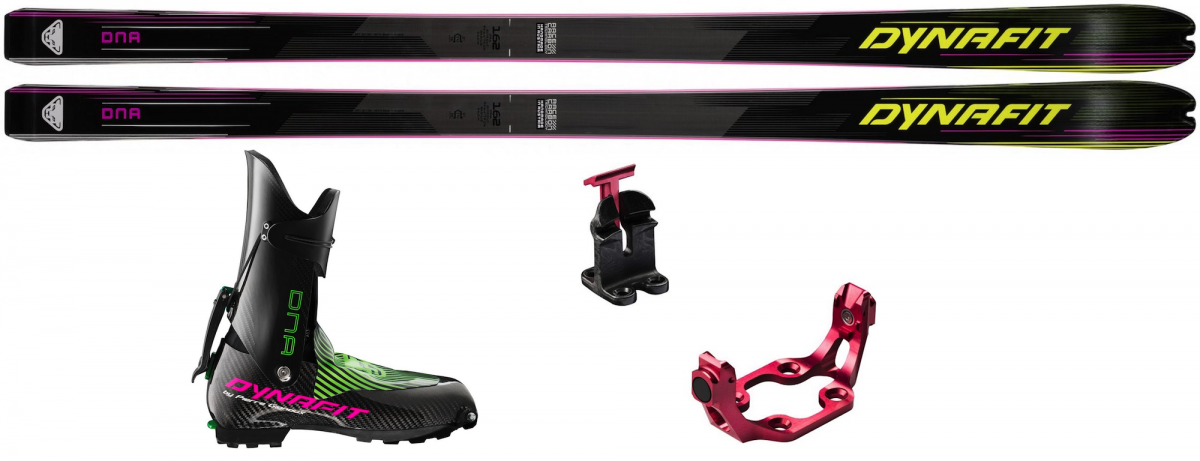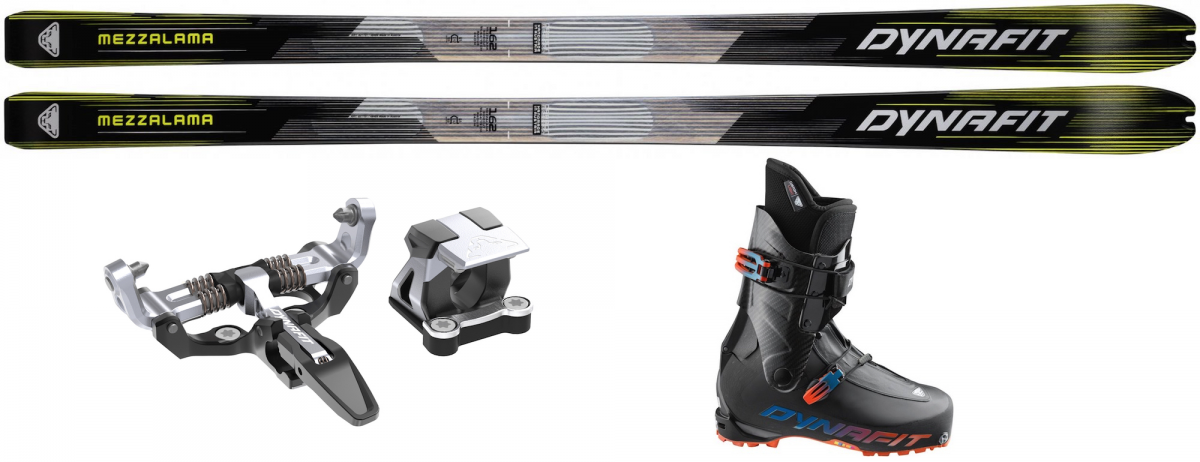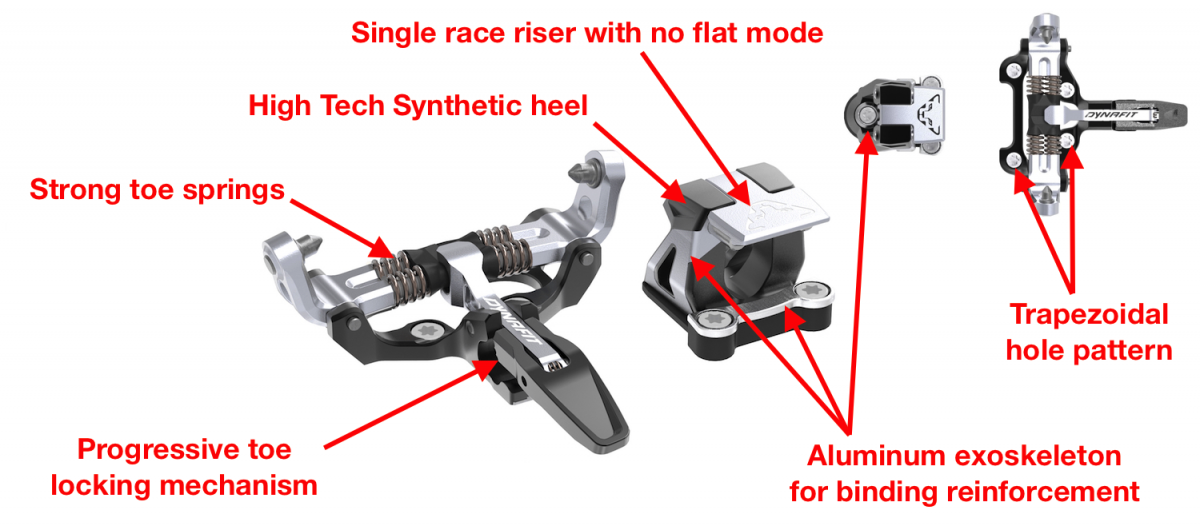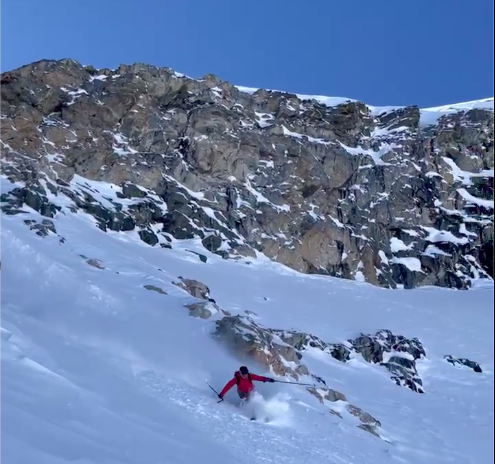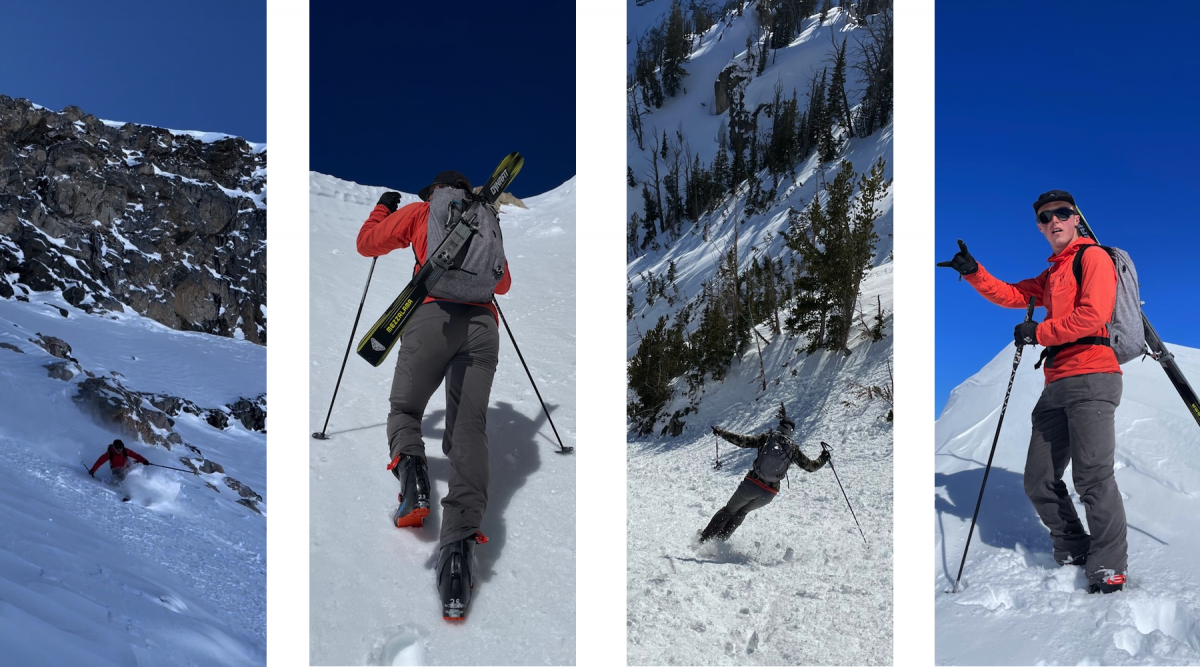
Here’s a montage of blurry photos from the backcountry race kit outing with Morgan McGlashon. The gist is skiing in the backcountry with race gear is easier on the up, harder on the down, and generally more dangerous with the increased potential for falling or breaking gear.
In Part I, Slator reviewed the Dynafit Mezzalama ski and PDG 2 boot. Check out that post to get the full context on the rest of the review that follows.
Low Tech Race 105 Binding
Am I going to beat the heavyweight race gear drum further with the description of the Low Tech Race 105 (LTR 105)? Yes, I will. The LTR 105 is a binding that continues the clearly defined delineation of race-weight versus training-weight gear within the Dynafit Race series:
Race-weight: The DNA ski / DNA boot / P49 binding. This creates a total skis/boots/bindings package that weighs a scandalous 1,249 grams. This gear is not recommended to train with or take outside of ski resorts or flagged off skimo race courses.
Training-weight: The Mezzalama / PDG 2 boot / LTR 105 binding. This combo totals to a more civilian 1,715 grams. This gear is great for training, and possibly for big backcountry ski mountaineering enchainments.
There is a 466 gram difference (the price difference of $4,200 vs $2,100 will be left to discuss in the comment section below) between the race-weight and training-weight packages.
Looking at the Low Tech Race 105 with more focus, I find an atypical race binding (which isn’t immediately a bad thing). The toe and heel have different mounting patterns compared to other race binding equivalents like the Plum 99, the Ski Trab Gara Titan, or the BD Helio 145 (all of which share a standard race binding mounting pattern). The LTR 105 toe has a trapezoidal hole template design that Dynafit claims to decrease binding tear-out. The heel has a triangular hole template design that cuts weight by reducing the amount of screws needed. This inherently increases binding tear-out (less points of attachment equals more force imparted on each attachment point). Maybe I’m simply adverse to change, but I feel the standardized rectangular hole pattern is simple and effective.
The LTR 105 toe unit has a strong spring set which is confidence-inspiring while clicking in, and the toe lever has a progressive lock mode to accommodate worn out tech inserts. Both quality design features. The heel is a non-U-spring race design including two threaded steel rods that sit in a High Tech Synthetic (plastic) housing. The housing is reinforced with an aluminum exoskeleton for structural rigidity both around the tech inserts and around the binding screws. The lack of a flat mode is a serious down-sell for this binding and the plastic housing doesn’t inspire aggressive [Attack Turtle style] skiing like an all metal equivalent. Dynafit addressed former issues of concern while redesigning their race skis, and again with their race boots. I would imagine that they’ll do the same in the near future with their race bindings.
SPECS
Mass (g) claimed: 106, measured: 120
BSL Adjustment Range (+/- mm) 0 mm (Adjustment Plate Low Tech Race available, +/- 10 mm, 33 gram)
Riser Options 1 at pin height
Release Values (vertical / horizontal) None stated
Materials Forged Aluminum toe and exoskeleton heel, High Tech Synthetic heel, Stainless Steel tech inserts
Brake Options Low Tech Race Brake available (30 g)
Ski Crampon Capability Yes
Mounting Pattern Toe: Trapezoid, Heel: Triangle
MSRP: $549.95
Recommendations
Boot Pairing: Race boot like the Dynafit PDG 2
Ski Pairing: Race ski like the Dynafit Mezzalama
Similar To: Ski Trab Gara Titan, Plum 99
Intended Use: Skimo racing and training. Not ideal for backcountry use
Overall: Simple lightweight skimo binding with no flat mode
Taking skimo to the backcountry
I went for a long backcountry tour with my friend Morgan who’s very experienced moving in the mountains and works as a mountain guide for Exum Mountain Guides based out of Jackson, WY. She was interested in a high volume training day moving in the alpine. I had used the Dynafit Race setup for fitness touring on the resort, but this would be a great excuse to test out the race gear off-piste.* Here are some lessons learned from our outing:
— Race skis make going uphill about 70% easier (empirically-hollow, feelings-based metric). Turns out having gear about 70% lighter than my traditional touring gear makes the uphills feel easy and breezy.
— Breaking trail with race skis doesn’t make it much easier for your non race ski friends following behind. They will be re-breaking trail and quietly cursing your skinny skis.
— Skiing downhill in race gear takes significantly more energy. It’s a full body workout keeping enough tension to manage backcountry snow conditions on unwieldy race gear. This was a surprise that I will definitely take into account moving forward when race gear+backcountry terrain tour planning.
— Skiing downhill on race gear in variable snow is a serious hazard. Breakable crust, heavy powder and icy luge-style out tracks are dangerous. Wear a helmet and don’t expect to ski freeride style.
— There is a possibility of race gear breaking and some might argue that this equipment isn’t intended for backcountry skiing of specific sorts. Be prepared for equipment malfunction/failure. Bring a fix kit and have a plan. This point scales linearly with your weight/size. If you’re a bigger person on light gear, you’re exerting more force on that kit.
Closing thoughts
The Dynafit Mezzalama ski, LTR 105 binding, and PDG 2 boot are skimo gear that feathers the boundary of backcountry-capable kit while still being light enough to compete at a high level of skimo racing. The skis are a great update with their new shape and construction. The bindings and boots could benefit from a similar update (which is already in the pipeline for the 21/22 season for Dynafit race boots).
Shop for the Dynafit LTR 105 binding
*The true story is I forgot my ski boots that day (doh!). I wasn’t going to miss the chance to spend a full day in the mountains with my best friend, so this tour was a better excuse than any to test out the race gear.
Slator Aplin lives in the San Juans. He enjoys time spent in the mountains, pastries paired with coffee, and adventures-gone-wrong. You can often find him outside Telluride’s local bakery — Baked in Telluride.

